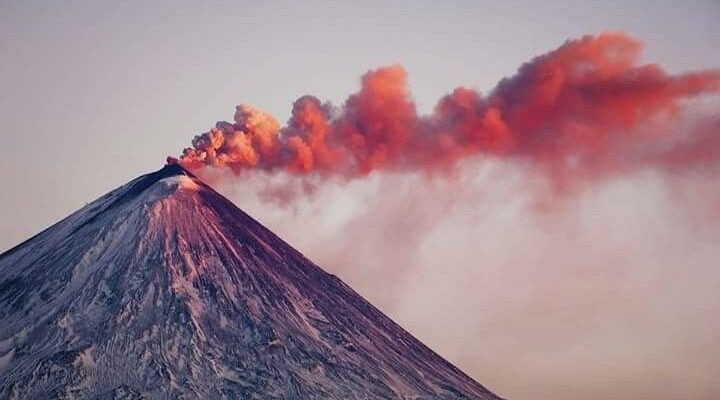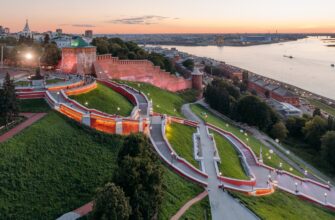In the rugged, untamed expanse of Russia’s Far East, a land where fire meets ice, the Kamchatka Peninsula is once again reminding the world of its formidable geological power. Recent seismic stirrings and volcanic eruptions, particularly from the Krasheninnikov and Mutnovsky volcanoes, have brought this remote region into sharp focus. While the plumes of ash ascend dramatically into the sky, the true impact on local life, particularly the burgeoning tourism industry, and the broader geological landscape is a nuanced story of nature`s unpredictability and human resilience.
The Fiery Ballet: Krasheninnikov and Mutnovsky Take Center Stage
The latest act in Kamchatka`s ongoing geological drama began with the Krasheninnikov volcano, an ancient giant that had slumbered for approximately 600 years. Its awakening was marked by an ash plume that soared an impressive six kilometers (nearly four miles) above sea level, a stark visual testament to the forces at play beneath the Earth`s crust.
Simultaneously, activity was noted at the Mutnovsky volcano, another prominent feature of the Kamchatka landscape. Geophysics experts from the Kamchatka branch of the Geophysical Survey of the Russian Academy of Sciences reported a thermal anomaly at Mutnovsky, prompting the issuance of a “yellow” hazard code. This classification signifies a heightened state of unrest, urging caution for anyone in the vicinity.
Proximity to Paradise: The Valley of Geysers
The Krasheninnikov volcano, now actively venting, lies approximately 30 kilometers (about 18.6 miles) from the renowned Valley of Geysers. This UNESCO World Heritage site is one of Kamchatka`s premier tourist attractions, drawing visitors from across the globe with its unique geothermal features. The proximity naturally raises concerns about the safety of tourists, should the ash plume shift its trajectory.
However, as experts from the Institute of Volcanology and Seismology note, the current wind patterns are a stroke of luck. The ash plume is primarily dispersing towards the Pacific Ocean, away from the delicate ecosystem and visitor routes of the Valley of Geysers. This favorable wind direction has, for now, mitigated immediate dangers.
Tourism in the Shadow of Giants: A Calculated Risk?
The summer season is prime time for tourism in Kamchatka, and one might expect widespread alarm or tour cancellations in the face of volcanic activity. Yet, the reality on the ground paints a different picture. Local tour operators appear remarkably unfazed.
Alena Gorokhova, a regional representative for RussiaDiscovery in Kamchatka, explained the prevailing calm: “Ascending Mutnovsky volcano has been prohibited for a long time due to its active state and crater wall collapses. So, nothing terrible is happening; it`s the same situation as before. We don`t use that route anyway.” She further elaborated that helicopter tours to the Valley of Geysers are flexible and can adjust routes based on weather and volcanic conditions, much like a seasoned pilot avoids turbulence. “The plume is going towards the Pacific Ocean; it`s not going towards the Valley of Geysers. We got lucky with the wind.”
This sentiment is echoed by other operators, who report no mass cancellations. Tourists themselves seem surprisingly sanguine. Polina Tynovskaya, a visitor to Kamchatka, confirmed that her tour operator had issued no warnings or cancellations related to the volcano, only standard weather-related delays. This lack of overt concern from those directly affected underscores a certain familiarity with Kamchatka`s volatile nature.
Intriguingly, past volcanic events have sometimes spurred, rather than deterred, tourism. The 2011 eruption of Plosky Tolbachik, which produced spectacular lava flows, reportedly drew a significant influx of visitors eager to witness such a rare natural phenomenon firsthand. The allure of seeing an active volcano, a truly once-in-a-lifetime experience for many, adds a peculiar dimension to the region`s tourism appeal.
The Earth Trembles: Unpacking the Seismic Connections
The recent volcanic outbursts did not occur in isolation. They followed a powerful magnitude 8.7 earthquake off the Kamchatka coast on July 30, which also triggered a tsunami that partially damaged local port infrastructure. This sequence of events naturally leads to questions about the interconnectedness of Kamchatka’s geological unrest.
Petr Shebalin, chief researcher at the Institute of Earthquake Prediction Theory and Mathematical Geophysics of the Russian Academy of Sciences, offered a scientific perspective: “The connection between earthquakes and volcanism is not direct, but they do share a common cause. An earthquake wave could, to some extent, provoke an acceleration of volcanic processes, but this earthquake could not have provoked the preparation of a volcanic eruption in any way. Nevertheless, there`s possibly a connection, though very difficult to establish, between the earthquake and the activated volcanism.”
Predicting volcanic eruptions or earthquakes with precise timing remains a formidable challenge for scientists. While some methods exist for monitoring significant volcanoes in Kamchatka, short-term earthquake forecasts are still far from accurate. Shebalin noted that the recent powerful earthquake likely released accumulated stress in its immediate zone, making another earthquake of similar magnitude unlikely there in the immediate future. However, strong aftershocks remained a possibility for a few weeks, with one of magnitude 6.8 recently observed north of the Kuril Islands.
Navigating Kamchatka`s Untamed Beauty
Kamchatka, often dubbed the “Land of Fire and Ice,” is a place defined by its raw, untamed natural beauty and its ever-present geological activity. While the recent eruptions serve as a potent reminder of this dynamic environment, the response from local authorities, scientists, and the tourism industry reflects a practiced understanding of living with and navigating these powerful forces.
For now, the winds carry the ash away from the populated and most frequented tourist areas, allowing life and tourism to continue its course. Yet, the awakened giants stand as a constant reminder that in Kamchatka, nature always holds the ultimate say, offering both breathtaking spectacle and the subtle promise of future geological surprises.









